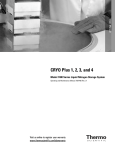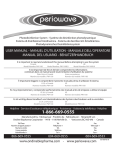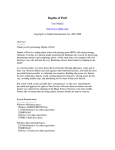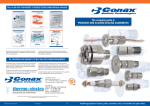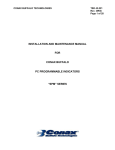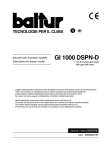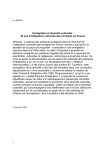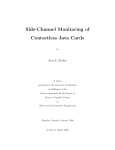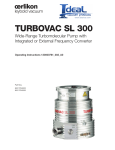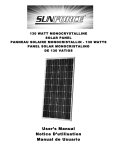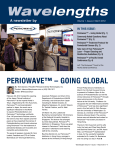Download research
Transcript
Photon Intermediate Direct Energy Conversion Using a Sr-90 Beta Source __________________________________________________________________ A Dissertation Presented to the Faculty of the Graduate School University of Missouri - Columbia _______________________________________________________ In Partial Fulfillment Of the Requirements for the Degree Doctor of Philosophy _____________________________________________________ by Robert J. Schott Nuclear Science and Engineering Institute December 2012 The undersigned, appointed by the dean of the Graduate School, have examined the dissertation entitled PHOTON INTERMEDIATE DIRECT ENERGY CONVERSION USING A SR-90 BETA SOURCE presented by Robert Schott, a candidate for the degree of Doctor of Philosophy, and hereby certify that, in their opinion, it is worthy of acceptance. (Dr. Mark Prelas) (Dr. Tushar Ghosh) (Dr. Robert Tompson) (Dr. Sudarshan Loyalka) (Dr. Dabir Viswanath) ACKNOWLEDGEMENTS I would like to express my gratitude and appreciation for all of the help and support I have been given during my time here. The faculty and my fellow students have been very helpful along the way. The program and support have been incredible. While many have helped me or been friends along the way there are a few I would like to call out specifically. There are many others but these helped me the most along the way. Dr. Mark Prelas was always ready to give advice on any problems. He was always friendly, regardless of the issues that arose. Without his help neither this thesis nor the paper would have made it to completion. Dr.’s Lynn and Annie Tipton helped a great deal in the early portion of the project with guidance and moral support. They left long before my graduation but their influence was felt throughout my entire time in the nuclear engineering program. Dr. Eric Lukosi helped me work through a few difficulties by talking things through and with a helpful bit of code. His dedication and drive were always an inspiration. ii TABLE OF CONTENTS ACKNOWLEDGEMENTS .................................................................................................................... ii LIST OF TABLES........................................................................................................................... v LIST OF FIGURES........................................................................................................................ vi ABSTRACT ...................................................................................................................................viii I NTRODUCTION .............................................................................................................................. 1 LITERATURE REVIEW ....................................................................................................................... 3 MATERIALS AND EXPERIMENTAL DESIGN ........................................................................................... 8 Primary System Components: ................................................................................................. 8 Source Information: .............................................................................................................. 12 Crafting Mirrors: ................................................................................................................... 16 MIRROR CHAMBER :.................................................................................................................. 19 METHODOLOGY ........................................................................................................................... 22 Preparation Work: ................................................................................................................ 22 Radiation Zone and Procedures: ............................................................................................ 25 Noise Issues: ......................................................................................................................... 27 Argon Gas Density: ................................................................................................................ 30 PIDEC System: ....................................................................................................................... 31 Description:....................................................................................................................... 31 Outgassing: ....................................................................................................................... 32 Experimental Procedure (Argon): ...................................................................................... 33 Experimental Procedure (Xenon): ...................................................................................... 38 RESULTS ..................................................................................................................................... 39 Solar cell photovoltaic: .......................................................................................................... 39 PIDEC System: ....................................................................................................................... 42 Argon: ............................................................................................................................... 42 Xenon: .............................................................................................................................. 44 Efficiency:.......................................................................................................................... 45 Photovoltaic Damage: ....................................................................................................... 50 C ONCLUSION ............................................................................................................................... 52 ADVANCED PIDEC CONCEPTS/FUTURE WORK .................................................................................. 53 iii Appendices ............................................................................................................................... 56 Appendix 1 – Radiation Work Paperwork .............................................................................. 56 Appendix 2 – Tabulated Results............................................................................................. 69 Appendix 3 – Pictures of Setup .............................................................................................. 70 Appendix 4 - Paper submitted to Nuclear Technology ........................................................... 74 REFERENCES ................................................................................................................................ 89 VITA .......................................................................................................................................... 91 iv LIST OF TABLES Tables Page Table 1 – Potential Beta Nuclides .....................................................................................5 Table 2 – Pressure System Component List ......................................................................8 Table 3 – Mirror Chamber System Component List ........................................................10 Table 4 – Strontium-90 Decay Parent/Daughter ............................................................12 Table 5 – Figure 20 Argon Tabulation.............................................................................69 Table 6 - Figure 21 Xenon Tabulation .............................................................................69 v LIST OF FIGURES Figures Page Figure 1 – Pressure Vessel Schematic.............................................................................10 Figure 2 – Source Rod Schematic ...................................................................................11 Figure 3 – Source Rod Photo ..........................................................................................11 Figure 4 – Strontium-90 Source Data Sheet ...................................................................13 Figure 5 – Strontium-90 Quote ......................................................................................14 Figure 6 – Strontium-90 Container and Button Picture ..................................................15 Figure 7 – Mirror Chamber Schematic ...........................................................................20 Figure 8 – Aluminum end cap with mounted photovoltaic .............................................21 Figure 9 – RadioShack solar cell .....................................................................................23 Figure 10 – Noise 1 ........................................................................................................28 Figure 11 – Noise 2 ........................................................................................................29 Figure 12 – Noise 3 ........................................................................................................29 Figure 13 – Argon Gas Density .......................................................................................30 Figure 14 – Rough PIDEC System Schematic ...................................................................32 Figure 15 – Solar Cell, Room Light, No Source, Pre-exposure .........................................39 Figure 16 – Solar Cell, No Light, No Source, Pre-exposure ..............................................40 Figure 17 – Solar Cell, No Light, Source ..........................................................................40 Figure 18 – Solar Cell, Light, No Source, Post-exposure ..................................................41 Figure 19 – Log Plot of Average Voltage for Solar Cell Tests ...........................................41 vi Figure 20 – PIDEC Argon Result ......................................................................................43 Figure 21 – PIDEC Xenon Result .....................................................................................44 Figure 22 – NIST Calibration and Recalibration ..............................................................51 Figure 23 – Radiation Survey .........................................................................................57 Figure 24 – Radiation Work Permit 2009-10 ..................................................................63 Figure 25 – Radiation Work Permit 2011-06 ..................................................................68 Figure 26 – High Pressure Connections and Valves; Safety Forms ..................................70 Figure 27 – High Pressure Vessel (top view) ...................................................................71 Figure 28 – Photovoltaic in Packaging ............................................................................72 Figure 29 – Looking Down the Mirror Chamber .............................................................72 Figure 30 – Badge Cabinet and Radiation Safety Sheet ..................................................73 Figure 31 – Faraday Cage, Pressure Vessel, Tubing and Valves, Heating Tape, Pressure tabtab Gauge, and Vacuum Pump .................................................................................73 vii ABSTRACT This thesis covers an examination of a need for a compact, long lived power source and a proof of concept for one such design. To begin, tests were done dealing with photovoltaics and their lifetime while undergoing radiation damage from the source of interest, Strontium-90 (Sr-90). After completing these tests a system was designed, built, and ultimately tested over a range of pressures in order to test if a Photon Intermediate Direct Energy Conversion (PIDEC) system would be potentially viable. In brief, the PIDEC system tested for this thesis used two excimer gasses, Argon and Xenon, to produce photons. These gasses were excited into excimer production using a 10 mCi Sr-90 source and held in place at pressures ranging from 10-6 to 2400 psi by a pressure vessel. Photons produced were guided towards a photovoltaic by a mirror chamber lined with high efficiency aluminum mirrors. Outside of the pressure vessel a picoammeter read the current off of the photovoltaic and sent the current to a computer for data processing. Of primary interest was how the current changed based on the amount of energy captured by the gas plenum which was related to the pressure of the system. The overall efficiency of this system was low due to a non-optimized waveguide, much of the beta energy being lost beyond the gas plenum, and other factors. However, viii the results were sufficient to show that the process was successfully completed and making a new system to optimize for these features is warranted. ix INTRODUCTION The goal of a Photon Intermediate Direct Energy Conversion (PIDEC) system is simply to match the scale length of the radiation range to the scale length of the transducer for a long lifetime, maintenance-free power source − a nuclear battery.[1] This battery would be capable of supplying electrical current to devices in any setting where replacement of the battery would be problematic, such as in the depths of the ocean or the remote reaches of space. Even more ordinary hand-held devices would benefit from a battery that would not need to be replaced for the lifetime of the device. Here, a proof of concept is demonstrated for a PIDEC system using Strontium-90 (Sr-90) that shows no damage to the photovoltaic over more than 150 hours of exposure time and with a half-life of 28.78 years it would out-last chemical batteries. Radiation damage is prevented by both a lead shield and by the intermediary used to generate the photons that are used for power. This device was built to test various pressures in order to show increasing energy capture by the gas plenum as the pressure increased and thereby improving the scale length. Testing the fundamentals involved testing the Sr-90 source with conventional photovoltaics to see how long they would last before being rendered inoperable. This gave a baseline amount of time expected for other similar photovoltaics without needing to destroy 1 expensive equipment. These tests showed that with the high energy betas coming out of the source a photovoltaic would lose functionality rapidly and be inoperable in less than 5 minutes. Radiation hardened photovoltaics undergoing bombardment by beta particles with less energy are able to last much longer but they do so at reduced efficiency. With that completed, a high-pressure system was built that allowed for pressures ranging from vacuum up through 60,000 psi. However, for this test only normal tank pressure was used (maximum test pressure was 2400 psi), as that was determined to be sufficient to test the concept. Inside of the pressure vessel a source holder, photovoltaic mount, and waveguide was needed to safely convert the beta energy into useable current. For this a mirror chamber was made which is described in detail in the materials design section below. Once the system was complete tests were run using excimer forming gasses, Argon and Xenon, one at a time. These both showed a general trend upwards in current being generated as the pressure was increased. The overall efficiency of the system was very low, primarily due to a loss efficiency of 0.23% from such things as energy escaping the system, photon absorption and other factors, but it was still sufficient to demonstrate that a PIDEC system is viable. 2 LITERATURE REVIEW Here is a brief discussion of previous work that has gone into direct energy conversion and how PIDEC adds an extra step that solves long term viability issues. Direct energy conversion systems place a source either in direct contact with a semiconductor p-n junction or using a beam of electrons or other charged particles [2] [3] [4] [5]. Beta particles enter the semiconductor and its energy is deposited directly into the material. During this step if energy is deposited the semiconductor may be damaged, reducing its ability to generate a useable current, or the energy could be put in a place where it might be useful: the depletion layer. When energy is deposited in the depletion layer of the junction it may create a hole-ion pair which can then migrate to create a current across the photovoltaic [6]. Energy deposited outside of this region is typically considered lost. While under bombardment the physical structure of the semiconductor will be changed. This change could cause defects to form in the semiconductor limiting its ability to transfer charge properly; eventually this damage cumulates enough to render the photovoltaic useless. Because of this damage, an alternative method of utilizing the beta particle’s energy is needed. A PIDEC system, as mentioned earlier, uses an indirect method of power conversion through excimer formation [1] [7]. 3 Excimer formation is the most important aspect of this system and it has undergone a great deal of study [8] [9] [10] [11]. An excimer gas may undergo excitation and decay without suffering from damage or reduction in efficiency an unlimited amount of times. This allows for its time frame of use to greatly exceed that of an application where radiation impinges directly onto a photovoltaic. The word excimer itself comes from ‘excited dimer,’ where a dimer is simply two identical atoms or molecules. In the case presented here, two noble gases, Argon and Xenon, will be used as the excimer forming gas, one at a time. While in its ground state, these noble gases interact in a repulsive manner, they stay dissociated and so do not normally form molecules. When, for example, an Argon atom is impinged upon by, in the case presented here, a beta particle there is at most a 50% [10] probability that an excitation will occur that will allow for the formation of an excimer. Once formed this unstable molecule breaks apart rapidly [8] [12]. The primary influences on this process are the temperature, the level of impurities, and the pressure of the gas. Gas temperature influences two-body reaction rates in Argon and Xenon strongly at high temperature but has a slow drop off for low temperature [11]. Impurity levels impact the formation of desired excimers by either forming other non-preferred excimers, such as if there is a different noble gas in the mixture, or through quenching, such as when oxygen [12, 13] is in the system which will interact with the Argon or Xenon atom without forming the desired photon. Finally, pressure, the variable which will be changed in this 4 experiment, increases the rate of two body reactions asymptotically up to a maximum after a few atmospheres while three body reaction rates continue to increase [12]. In this experiment pressure will be changed while holding temperature constant and using a highly pure Argon source for one test and a combination of Xenon and Helium for another. Over the pressure ranges to be used, from vacuum up to normal tank pressure of around 2200 psig, reaction rates should be high enough that excited pair reactions will be minimal. As the gas pressure increases, and the gas density along with it, the path length of the beta particles will decrease, putting more of their energy into the gas [6]. In order to have a process that can excite the excimer gas without needing excessive shielding a radioactive source is needed that has sufficiently energetic particles without unwanted radiation; primarily in the form of gammas. It was decided to use a beta source in this experiment with others doing an alpha experiment. The table below has a number of potentially suitable candidates. Parent nuclides are on the left while all subsequent daughters are on the right. Table 1 – Potential Beta Nuclides Nuclide Parent H-3 Daughter Decay Energy (MeV) Half-Life (yr) 0.019 12.3 He-3 - - 5 Comments Ar-42 0.6 32.9 K-42 3.525 0.0014 Ca-42 Co-60 - 2.824 5.2713 Ni-60 Kr-85 - 0.687 10.755 Rb-85 Sr-90 0.546 28.77 0.0073 Zr-90 - Sb-125 - 0.039 1.0234 Rh-106 3.541 9E-7 Pd-106 - - 0.767 2.73 Te-125 Cs-137 1.175 30.10 0.076 - 0.253 4.67 Gammas - 0.096 1.92 Yb-171 Os-194 Gammas 90 Gd-155 Tm-171 Gammas - Eu-151 Eu-155 Gammas - Ba-137 Sm-151 Gamma - Y-90 2.280 Ru-106 Strong Gamma - 0.097 6.00 Ir-194 2.247 // 2.437 0.0022 // 0.468 Pt-194 - - 6 Gammas The most desirable radioisotope would have the following qualities: Few to no gammas, a half-life of at least 10 years, generate at least one sufficiently energetic beta particle, and be readily available. It was decided to use Sr-90, with its highly energetic beta producing daughter Y-90, as the radioisotope for this experiment. Sr-90 is readily available from distributers; a 10 mCi source was obtained from Isotope Products Laboratories. With a half-life of almost 30 years it would work well in a long duration battery and would allow for a large amount of fairly steady state testing. The Y-90 daughter does have a small abundance (<1.0E-3%) of a gamma but this was deemed to be sufficiently low enough to ignore. 7 MATERIALS AND EXPERIMENTAL DESIGN Detailed below are the components used in making the system along with how key components were crafted. Primary System Components: Table 2 – Pressure System Component List Type Pressure Vessel Serial/Model R2-10-40 Coupling/ Adapter 30-21HF6NMB 30-21HM6NMB High Pressure Valves 60-11HF6 60-15HF6 Elbows/Tees Nipples 60-22HF6 60-23HF6 60-HM6-3 Description Amount 8 ½” O.D., 40,000 psi, 1 highpressure.com 10”Inside Depth, 4340 alloy steel, ~160 lbs, 3 pressure tubing ports 3/8” High Pressure to ¼” 4 highpressure.com Female NPT Pipe 3/8” High Pressure to ¼” 4 highpressure.com Male NPT Pipe 2 Way Straight Valve 3 highpressure.com 3 Way/2 Stem Connection Valve High Pressure Elbow High Pressure Tee 3” Nipple 8 8 highpressure.com 13 3 10 highpressure.com highpressure.com highpressure.com Ball Check Valve Wire Feedthrough 60-HM6-6 60-HM6-8 60-HM6-12 60-41HF6 HPPL14(AM3/S316 B)-24(4AL/1K)A(/S316B)6CGL,24/24 Vacuum Pump Trivac D16B Picoammeter Keithly 6487 Pressure PG5000 Gauge Power Supply PS-21KX Power Inverter Transformer AC Power Conditioner Faraday Cage 6” Nipple 8” Nipple 12” Nipple Unidirectional flow valve 4 4 4 4 highpressure.com highpressure.com highpressure.com highpressure.com (4) 24 AWG Alumel wires, (1) 24 AWG type K T/C pair 1 conaxbuffalo.com Rated 10-6 psi 1 1 1 www.swagelok.com 0 to 5000 psi 1 PW1100-12 Input 115V AC 60 Hz 450 W, Output 13.8VDC 20 amp 1100 Watt, 12V 1 Pyramid regulated power supply PowerBright GIS-500 SA-20 1115V, 50-60Hz 120V AC, 20 amps, 50-60Hz 1 1 Stancor SurgeX 1 9 Figure 1 – Pressure Vessel Schematic Table 3 – Mirror Chamber System Component List Type Glass (1st) Glass (2nd) Steel rod (inner) Steel rods (outer) Aluminum (end caps) Teflon (end caps) Photovoltaic Lead Plug Source Serial/Model Custom custom 8890K451 9120K9 88685K73 Description Amount 1”×3/16”×9 ½” 12 www.qsiquartz.com 1”×3/16”×8 ½” 12 www.qsiquartz.com 12” (used 4” rod) 1 www.mcmaster.com 3’ (3 - 8” rods) 1 www.mcmaster.com 1100, 2’×2’ (2 end 1 www.mcmaster.com caps) 8545K18 6"×6"×3/8" (2 end 1 www.mcmaster.com caps) 01-527 Si photovoltaic 1 www.ird-inc.com Shaped lead fishing weight 1 Figure 4, Figure 5, Figure 6 10 Keithley Computer 6487 picoammeter Figure 2 – Source Rod Schematic Figure 3 – Source Rod Photo 11 1 1 www.keithley.com Source Information: 10 mCi Strontium-90 (Sr-90). Table 4 – Strontium-90 Decay Parent/Daughter Half-life Decay Type Energy Gamma Daughter Strontium-90 (Sr90) Yttrium-90 (Y-90) 28.78 years 64 hours Beta 0.546 MeV (max) 0.18 MeV (avg) Beta 2.280 MeV (max) 0.92 MeV (avg) N/A <0.001% 2.186 MeV Yttrium-90 Zirconium-90 12 Zirconium-90 (Zr-90) Stable Figure 4 – Strontium-90 Source Data Sheet 13 Figure 5 – Strontium-90 Quote 14 Figure 6 – Strontium-90 Container and Button Picture 15 Crafting Mirrors: Polished quartz glass (1” × 3/16” × 9 ½” and 1” × 3/16” × 8 ½”) was used as a base upon which Aluminum (Al) and Magnesium Flouride (MgF2) were evaporated to form mirrors. MgF2 was needed as Al oxidizes quickly to a state with poor reflective qualities for ultraviolet photons. The steps used to create the mirrors were as follows: 1) The evaporation chamber was prepared. a. Two tungsten boats and one tungsten wire boat were taken. b. One boat was used as a blank to heat the chamber. This sped up desorption from the walls. c. The other boat had an amount of MgF2 placed on it while the wire boat was used for Al. Using the density of each (3.15 g/cm3 and 2.70 g/cm3, respectively) and the equation below the desired thickness was reached. (1) 16 d. In order to have sufficiently thick Al and sufficiently thin MgF 2 we used 1 g of Al and 0.03 g of MgF2. 2) Cleaning the glass surface removed any contaminants. a. An alcohol bath with low particulate and non-residue wipes removed gross contaminants. b. De-ionized water and non-residue soap (Alconox) and the same wipes were then used to remove anything that remained. c. Regent grade acetone was then poured over them to dry them quickly without leaving anything behind. 3) The glass was then immediately placed onto a rotary rack and held in place with screwed down metal bands at each end of the glass. This assembly was then set into the evaporation chamber. 4) The evaporation chamber was pumped down to remove any oxygen. Typically this took several hours and the empty slide was used to heat the chamber, expediting the process. 5) In order to help ensure even coatings the rotary rack was turned on to about one revolution per second. 6) Aluminum was then flash evaporated. Typically, this was a slow ramping up in power until the aluminum would start to visibly change (moving or melting) and then a quick ramp in power high enough to flash it out. This allowed for the greatest amount of aluminum to be evaporated before it crept out of the boat. Often less than half of the Al was actually evaporated. 17 7) The MgF2 was then evaporated by increasing the power slowly until it all disappeared from the boat; it was much easier to work with than the aluminum. 8) Once this was all completed the rotation was turned off and the system was repressurized. 9) Mirrors were then checked for any obvious issues. These are generally either small particulates that adhered to the surface after the last rinse or streaking due to residues that remained. Generally, mirrors with these issues would have the Al and MgF2 removed and then be cleaned again so that they could be put through the process again. Example evaporation: Boat pre-mass (g) Sample mass (g) Boat after evap (g) Wire boat (Al) 2.757 0.980 3.235 Boat (MgF2) 6.580 0.032 6.576 18 MIRROR CHAMBER : A waveguide was made that would help excimer photons reach the photovoltaic while limiting radiation damage that would occur from the beta and bremsstrahlung radiation. In Figure 7 below each component can be seen. This is the first version used. The later version used Teflon end caps instead of Al in order to limit conduction paths that might have been causing problems. In the end there was no noticeable change between the two versions. As mentioned in the section on mirror creation, two different lengths of mirrors were used. The first length used was 9 ½” but it was found that at this length the pressure vessel was unable to fully close before the mirror chamber itself would be compressed by the plug. Sometimes this contact would pull the wires out, causing a need to stop the experiment and set it up again, while other times the pressure vessel would release prematurely which would not allow for a full test to be completed. This lead to the use of 8 ½” long glass instead which alleviated these problems. 19 Figure 7 – Mirror Chamber Schematic Not shown in Figure 7 above are wires that come out of the top from the photovoltaic and three rods that connect each of the bases together. 20 Figure 8 – Aluminum end cap with mounted photovoltaic In Figure 8 the holes where the rods would touch can be seen. Running through the holes are screws that thread into each end of the rod such that it is possible to tighten both ends simultaneously. 21 METHODOLOGY Preparation Work: In preparation for testing PIDEC a simple experiment was performed on several silicon photovoltaics (solar cells). These tests were performed to determine the rate at which radiation from the Sr-90 source would cause degradation in the photovoltaic as a baseline for what a similar test would do to the calibrated source used in the PIDEC experiment. These silicon solar cells were purchased from RadioShack (Model & Catalog #: 276-124, 0.3 amps at 0.55 VDC in full sunlight, 0.8”x1.6”, Figure 9). A DAQ board and computer were used for data collection. A black box was used that could either be closed off completely from ambient light or left open to allow light from a fluorescent light in. Each solar cell went through an initial test to make sure that they were functioning properly. 22 Figure 9 – RadioShack solar cell The procedure for bare chips was as follows: 1) Wires were attached to the front and back at connection sites using silver solder, being careful not to let the photovoltaic get too hot. 2) Tested the resistance of connections from one point on the surface to the end of the wire. If there was a problem try step one again. 3) Mounted the photovoltaic in the black box, making certain that the light was at the correct position. The connections were then tested. 4) The box was then closed and a test was taken in the dark. Voltage data was then recorded. 5) The box was then reopened and a test was taken in the light. Voltage data was then recorded. 6) Radiation badges were then put into place and the radiation area was secured with signs. 7) Placed the source on the center of the photovoltaic with the ‘hot’ side facing it. 8) The box was then closed and a test was taken in the dark with the source. Voltage data was then recorded. 23 9) The source was then put away along with the badges. The radiation area signs were taken down. 10) With the box already open a test was taken in the light for a post-exposure reading. Voltage data was then recorded. Further tests were run using glass slides and stacking photovoltaics to try to limit damage over time without success. Enough shielding to extend the lifetime of the photovoltaics was also enough for the voltage response to be indistinguishable from the normal dark measurements. 24 Radiation Zone and Procedures: Working with EHS, specifically Mary Aldrich ([email protected]), the Sr-90 source radiation zone was established along with a procedure for safe handling. The specific paperwork from EHS is in Appendix 1. The procedure used was simple: 1) The radiation work permit (Figure 25) and radiation survey (Figure 23) forms were taken out and the initial sections were filled. 2) Badges were retrieved from their locked cabinet and put into place on all personnel who would be entering the radiation zone for the experiment. 3) The Ludlum model 3 radiation survey meter was then tested to ensure that it remained within calibration range. This information was recorded on its own notebook. 4) Prepared the experimental area including putting up the temporary radiation warning signs and getting the mirror chamber ready. 5) Following ALARA the source was then removed from the safe and placed into the mirror chamber, which was then installed into the pressure vessel. 25 6) If working with a second person the times would be recorded for each step above as they happened. If only one person was working then the source handling steps would be completed and then the times would be filled out, in order to minimize source exposure. 7) With the source in the pressure vessel the radiation survey of the experimental setup would be taken and recorded on the radiation survey form. *Note: On the radiation survey form, the ‘Storage’ survey and the ‘Experimental setup’ survey are listed in the opposite order in which they are taken. First, the experimental setup was done, as shown here. Later, the storage survey is performed.* 8) The experiment for the day would then be performed. Greater detail of this step is given in the PIDEC section below. 9) The mirror chamber was then removed from the pressure vessel, the source was removed from the mirror chamber, and the source was returned to the safe. 10) On the radiation survey form the ‘Storage’ survey is now performed along with the times on the radiation work permit. 11) The paperwork was then double checked for accuracy and filed away in its drawer. 12) The temporary radiation warning signs were then taken down and the badges were locked in their cabinet. 26 Noise Issues: During the experiment increasing noise issues led to using a number of noise dampening solutions. This noise came from known issues such as the building power being unstable, possibly due to a large amount of computers on the system along with other equipment, along with unknown ambient issues. In order to deal with the building power being disruptive a transformer (GIS-500, Stancor) and an AC power conditioner (SA-20, SurgeX) were installed. This helped but did not eliminate all of the noise, especially during peak usage hours of the rest of the building. After trying those two extra steps were put into place. These were taking the partially cleaned power and running it through an AC to DC power supply (PS-21KX, Pyramid) and then running that through a DC to AC power inverter (PW1100-12, PowerBright). This process cleaned the power sufficiently. The other noise issue was some unknown ambient. It was almost always there in some form but it changed in frequency, magnitude, and function often. In order to help eliminate this problem a faraday cage was brought in, all wires were shortened and wrapped in an extra layer of protection, and all of it was grounded on a dedicated ground separate from the building’s normal ground. This was sufficient only to eliminate some of the ambient noise but it was 27 reduced enough to be able to take measurements again. It did get rid of the long charge/discharge cycles most of the time and turning the room lighting on and off no longer changed the signal. Examples of noise problems resolved: 1E-12 5E-13 Current (Amps) -3E-26 0 20 40 60 80 100 -5E-13 -1E-12 -1.5E-12 -2E-12 Counts Figure 10 – Noise 1 28 120 140 160 180 200 7E-05 Current (Amps) 6E-05 5E-05 4E-05 3E-05 2E-05 0 20 40 60 80 100 120 140 160 180 200 Counts Figure 11 – Noise 2 1.35E-10 Current (Amps) 1.3E-10 1.25E-10 1.2E-10 1.15E-10 1.1E-10 0 500 1000 Counts Figure 12 – Noise 3 29 1500 2000 Argon Gas Density: Argon Gas 0.9 Density (g/cm3) 0.8 0.7 0.6 0.5 0.4 0.3 0.2 0.1 0 0 2000 4000 6000 8000 10000 12000 14000 Pressure (psi) Figure 13 – Argon Gas Density This graph shows the density of Argon as pressure increases. Near the beginning it is close to the ideal gas but by the end it diverges by a large amount. The vertical line represents the highest pressure reached in this experiment with a density of 0.27 g/cm3. With increasing density more of the beta particles energy can be captured over a smaller distance. However, it takes a greater and greater amount of pressure to achieve significant gains while at the same time the housing material must be further reinforced. 30 PIDEC System: Description: A rough basic diagram of the system is given in Figure 14 below. This experimental setup consisted of the following components: a picoammeter (Keithley Model 6487 and a computer used to operate and record data from the picoammeter are listed as ‘Computer system’; high pressure pipes, valves, and fittings (High Pressure Equipment Company, all rated to 60,000 psi); a UPC 5.5 argon gas tank or a combination of tanks for Xenon and a Helium fill gas listed as ‘Ar source’; a pressure vessel (R2-10-40); a vacuum pump (Trivac D16B) rated to 10-6 psi, a mirror chamber, and a Si photovoltaic (Manufactured by International Radiation Detectors (IRD), Serial Number: 01-527, calibrated by the National Institute of Standards and Technology (NIST)). 31 Figure 14 – Rough PIDEC System Schematic Outgassing: In order to ensure that the system was as free of contaminants as possible before tests, an outgassing procedure was performed before each new run of several experiments. This process involved using heating tape to heat the system and then cycle the system through vacuum and argon flushes. As the system takes quite some time to heat up and cool down this process typically took around 3 days. One day to heat up, one day to perform the flushes, and then another day to cool down. During heat up and cool down the vacuum pump was run continuously. 32 Between uses where a thorough outgassing should not be required the system was put under vacuum and then ~200 psig of argon pressure. Any loss in this pressure between runs would call for testing of all seals to make sure that they were in working order. Experimental Procedure (Argon): This procedure is extended from the radiation zone procedures above. It is expanding on step 8, “The experiment for the day would then be performed.” and checking the mirror chamber. 1) Checked and prepared system a. Made sure it was still under pressure from last use. If it was, then these steps would continue. If the pressure had fallen significantly then the system would have to be systematically pressurized until the leak was found and fixed, then the steps would continue. b. The relief valve was opened until the pressure inside of the system was near atmospheric and then it was closed. High pressure from the system was not allowed to enter the vacuum pump. c. The vacuum pump was then turned on and the system was opened to it. After at least 15 minutes of pumping it was sealed off from the rest of the system and then it was turned off. 33 d. The system was pressurized up to 500 psig argon and checked for leaks. If there were any they were fixed and the process was restarted from 1b. e. The relief valve was then opened until the system was at around 100 psig Argon. It was then closed and the piping leading to the gas was sealed off. f. The relief valve was again opened until the system was near atmospheric pressure and then closed again. g. The system was then ready to be opened and have the mirror chamber placed inside. 2) Checked computer system a. In order to assure that the Keithley was warmed up properly it was turned on and plugged into the computer at least an hour before it was to be used in an experiment. b. Opened excel in a new sheet or continued on an old, as desired. c. Went to Add-Ins -> ExceLINX -> Configure Meter to open up that worksheet. d. Went to Add-Ins -> ExceLINX -> Scan Meter to open up that worksheet. e. On the Configure Meter sheet made sure that the proper device was selected (KESCPI_GPIB_14*). f. Under the Status/Cmds tab selected, ‘Detect Device’. g. The device was then ready to interface from the Meter Scan page. h. On the Meter Scan page under Data Location, changed which worksheet, column, and row the data would be saved under to the desired location. 34 i. Under Sample Trigger on the Meter Scan page found the listing, ‘Count’. Selected the number of counts for the run. This was a number up to 2048, the maximum it would allow for selected counts, or infinite, which would have to be stopped manually. j. The computer system was then ready for testing. Starting the run then only took looking under ‘Task’ for ‘Status/Cmds’ and using the ‘Start’ option. 3) Checked mirror chamber. a. Unpacked it from its protective wrapping. b. Made sure that the mirrors were set into place properly and were not dirty. If they were dirty canned air was used to remove particulates, anything that this could not solve likely meant that the mirror would need to be replaced. c. Made sure that the holding rods and end caps were properly aligned. d. Tested the photovoltaic with the DMM to make sure it was still connected properly and was functioning. Reconnected wires or reset the photovoltaic as needed. e. The mirror chamber was then set near the radiation safe for quick placement of source. 4) Ran experiment a. Opened up the top of the pressure vessel and made sure that there was a clear path for the mirror chamber to fit in and that the o-ring was in place. If it was out of place, or a wire was trapped under it, a tool was used to resettle it properly. 35 b. The source rod was then placed into mirror chamber. c. The mirror chamber was then slid into pressure vessel and the internal wires were attached to it. Each connection was then tested to ensure proper functionality and reset if needed. d. Screwed down pressure vessel lid until chamber was sealed. Typically, all but the last revolution or so was easy. e. Made sure that the wires were still attached on the inside. If they were not then the Keithly would be giving either too high of a result (wires touching) or too low (displaced contact). If either of these happened, or there was continual charging and discharging showing up, then the pressure vessel was reopened and the connections were redone. f. The vacuum pump was then turned on and the valves between the vacuum and the system were opened. The vacuum was run for at least 15 minutes after which the valves between the vacuum pump and system were closed. The vacuum pump was then turned off. g. Pressurized the system to 200 psig of Argon. Sealed off the tank from the pressure vessel. Used the pressure relief valve to get back down to near atmospheric. h. Repeated steps f and g at least 2 more times each then finished with doing step f again. 36 i. The faraday cage was then closed, the vacuum pump was unplugged to reduce noise that could come from the power line it was on, and all safety connections were double checked to make sure they were in place. j. Took a reading at vacuum pressure immediately and then another after waiting at least 10 minutes. If on the second check there was still a noticeable amount of charge/discharge in the measured response then another 10 minutes was waited before taking another reading. This was repeated until a sufficiently steady result is returned. k. Increased the pressure to the next desired amount. Step j was then repeated with the new pressure in place of vacuum. l. Step k was then repeated until the desired maximum pressure had been recorded. m. Closed the valve to pressure tank and opened the pressure relief valve until the pressure in the vessel was close to atmospheric pressure. n. Opened up the pressure vessel and removed the mirror chamber. o. The source was then put away into the safe. p. Wrapped the mirror chamber in a protective wrapping. q. Made sure the wires were not in the way in the pressure vessel and that the o-ring was in place. It was then resealed. r. Vacuumed out the system as stated before, pressurized up to 200 psig of Argon, and then opened relief valve to bring pressure back down to near 37 atmospheric. This step was repeated 1 more time and then the vessel was pressurized up to 200 psig before being sealed to wait for the next test. Experimental Procedure (Xenon): This follows the same procedure as for Argon in every way except that instead of performing step 4j and on as written after the last vacuuming 200 psig of Xenon is put into the system and then Helium fill gas is put in until the system is at the top pressure desired. After that the readings proceed with decreasing pressure rather than increasing but the wait and recording times are all the same. This was done as the Xenon acquired was under too low of a pressure to hit the proper final pressure desired. This process kept the ratio of Xenon in the chamber roughly equal over the course of the experiment. 38 RESULTS Solar cell photovoltaic: Over 20 photovoltaics were tested as described in the methodology above. Below are several figures representing typical solar cell tests. The results of each were all similar to these. Solar Cell Fluorescent Light Box open, no source -0.2 Voltage (V) -0.21 0 10 20 30 40 50 60 -0.22 -0.23 -0.24 -0.25 -0.26 -0.27 -0.28 Data Points (60 Hz) Figure 15 – Solar Cell, Room Light, No Source, Pre-exposure 39 70 80 90 100 Solar Cell Dark Current 6.50E-05 Box closed, no source 4.50E-05 Voltage (V) 2.50E-05 5.00E-06 -1.50E-05 0 500 1000 1500 2000 -3.50E-05 -5.50E-05 -7.50E-05 -9.50E-05 -1.15E-04 Data Points (60 Hz) Figure 16 – Solar Cell, No Light, No Source, Pre-exposure Solar Cell Box closed, source -0.0031 0 200 400 600 800 1000 1200 1400 Voltage (V) -0.0032 -0.0033 -0.0034 -0.0035 -0.0036 -0.0037 Data Points (60 Hz) Figure 17 – Solar Cell, No Light, Source 40 1600 1800 2000 Solar Cell Box open, no source, post 5 min exposure Voltage (V) 2.00E-05 -3.00E-05 0 200 400 600 800 1000 1200 1400 -8.00E-05 -1.30E-04 -1.80E-04 Data Points (60 Hz) Figure 18 – Solar Cell, Light, No Source, Post-exposure Log Plot of Average Voltage 1 0.1 Average Voltage (V) Light, Pre-exposure 0.01 0.001 0.0001 No Light, Preexposure During Exposure Light, Postexposure 0.00001 0.000001 Figure 19 – Log Plot of Average Voltage for Solar Cell Tests 41 1600 1800 2000 With less than 5 minutes of exposure all of the photovoltaics tested were rendered effectively inoperable. PIDEC System: Data sets of average values are in tabulated format in Appendix 2. Argon: Figure 20 below shows a typical test using argon. It ranges from vacuum pressure (roughly 10-6 psi) up to 2200 psig. 42 0.25 Current (×10-10 A) 0.23 0.21 0.19 0.17 0.15 0.13 0.11 0 500 1000 1500 2000 Pressure (psi) Figure 20 – PIDEC Argon Result At the low end there is a current that is likely due to bremsstrahlung radiation from beta particles interacting with the steel and lead of the source holding rod, from the glass of the mirror chamber, and from the pressure vessel itself. As the pressure increases, the current from that process dies away as more of the beta energy is being captured by the gas and the bremsstrahlung radiation is damped by the gas both inside and outside of the mirror chamber. After the initial dip the current steadily increases with increasing pressure. Between 1000 psig and 1600 psig there is another slight reduction in current occurs. This is due to the lower energy beta of the Sr-90 reaching its peak geometrical optimum range in the gas for photon collection followed by a transition wherein the Y-90’s higher energy betas start 43 increasing their contribution to photon production. The range over which it occurs has to do with a combination of uncertainty in the pressure being measured and the orientation of the rod. When the rod is screwed into the base the exact placement of the hot/cold sides of the source was not well controlled. It was only recorded that the screwed section was roughly flush with the end cap. Xenon: 0.26 Current (10-10 A) 0.24 0.22 0.2 0.18 0.16 0.14 0.12 0.1 0 500 1000 1500 Pressure (psi) Figure 21 – PIDEC Xenon Result 44 2000 2500 Figure 21 above shows a representative Xenon run. The lower end of the pressure does not show the normal bump for two reasons. First, the procedure had to be changed in order to use Xenon which made hitting pressures much more difficult; this also accounts for the data point spread. Secondly, because of the method used, the ratio of Xenon to pressure was much more poorly controlled at that extreme end so the measurements taken there would have little meaning when compared to the other points plotted. However, the general trend seen in the Argon tests still holds. There is a general trend upwards in current as pressure increases except for a brief dip. The dip appears to have moved slightly towards a higher pressure range as well. Efficiency: The primary factors in determining the conversion efficiency of this system are energy deposition in the excimer gas, excimer gas fluorescence efficiency, photovoltaic photon conversion efficiency, and finally photon reflection efficiency. Using the MCNPX 2.6.0[14][14][14] [14][13][12][11][10][9][8][7][6] model[6][6][6][6][7] the percentage of energy released by the source that was deposited into the gas was 3.47%. This value is the 45 energy transport efficiency ( ) from the source to the gas plenum. This energy was deposited between the center rod and the glass mirrors which is illustrated by region 5 in Figure 7 – Mirror Chamber Schematic. Any energy deposited elsewhere was considered lost. Idealized numbers were used for fluorescence and photon conversion efficiencies. Excimer gases and fluorescence emission have been extensively studied and the maximum fluorescence efficiency ( ( ) for argon is 50% [1]. The photovoltaic energy conversion efficiency ) for a Si cell using the 129 nm excimer photon has a theoretical maximum of 5.7%[10][10][10] [10][11] [9][8] . This is shown in equations 2 and 3. Driving potential efficiency and fill factor were assumed to be ideal (0.5 and 1, respectively) and are defined in more detail in Oh’s paper[6][6][6][6][7] . (2) (3) The greatest loss in efficiency for this system occurs with reflections due primarily to the unoptimized design of the waveguide. Aluminum was used as it has a >80% reflectivity [15] for the deep ultraviolet photons of the Argon excimers but the number of reflections any photon may undergo is highly variable. In addition, the rod used to hold the source and the lead plug that topped it were not reflective. A coating of aluminum and MgF 2 was deposited on each but 46 resulted in a milky and dull appearance due to the incompatibility of the surface for mirror finishes. It was assumed that all photons striking either the rod or lead plug were lost. With these two factors the vast majority of photons created were not in the narrow window where they could be collected by the photovoltaic, making this factor the greatest loss in efficiency. Each Sr-90 decay eventually produces two betas. As the half-life of the daughter product, Y-90, is much shorter than the half-life of the parent, Sr-90, these two beta decays are assumed to be in secular equilibrium and so both are assumed to occur simultaneously. Sr-90 decays into Y-90 by emitting a beta particle that has a maximum energy of 0.546 MeV and an average of 0.18 MeV. Y-90 then also undergoes beta decay, forming stable zirconium-90, with a beta that has a maximum energy of 2.28 MeV and an average of 0.92 MeV. Using these average beta energies of 0.18 MeV and 0.92 MeV for Sr-90 and Y-90, respectively, total power output of the source, , is: (4) (5) (6) 47 Taking the highest value reached in Figure 20: (7) Gives an absolute efficiency of: (8) Using the above efficiencies we define the absolute uncertainty as all others multiplied together: (9) 48 Where is defined above as 2.3 × 10-6, source to the gas plenum given above as 3.47%, 50%[1][1][1] [1], is the energy transport efficiency from the is the fluorescence efficiency of argon, is 5.7% for a Si photovoltaic[10], and is the unknown loss coefficient due to photon absorption, energy deposited outside of the gas plenum, and all other losses. Solving for , (10) The photon transport efficiency, , is an area where substantial improvement can be made by using different reflective waveguide designs to shield the photovoltaic. Theoretical studies have been done for such configurations and could approach 70%[16] [17] [18]. The same experiment was then run with Xenon as the excimer gas rather than Argon. Xenon has a lower energy photon emission with a wavelength of 172 nm (7.2 eV) and so falls under a slightly better reflectance range (>90% possible) than the Argon eximer. Assuming all else to be equal except for the new photon wavelength, using the current from the Xenon test (Figure 21), and the new responsivity (0.11 A/W) the following efficiencies are calculated: (2) 49 (11) (12) (13) (14) Given that the Xenon highest current is at a slightly higher pressure than the Argon the two numbers are not directly comparable as to which is more efficient. However, it is clear that both have similar responses over the range that they were tested in. Also, since the decrease in responsivity going from Argon to Xenon is roughly the same percentage change as the increase in intrinsic photovoltaic efficiency going from a 129 nm photon to a 172 nm photon the final results being similar numbers at similar pressures shows a consistent result in this chamber. Photovoltaic Damage: Over the course of the experiment the photovoltaic was in close proximity for more than 150 hours. Based on the tests done with the solar cells any amount of time beyond a few minutes should have shown a large amount of degradation in the photovoltaics ability to generate current. 50 In Figure 22 below two calibration curves are shown. One was taken before any 1.600 Pre-Exposure 1.400 Post-Exposure 1.200 1.000 0.800 0.600 0.400 0.200 0.000 116.4 118.0 121.6 125.4 135.4 140.3 144.1 148.7 154.5 160.8 164.8 170.0 175.0 182.3 187.9 193.7 200.0 206.7 213.8 221.4 229.6 238.5 253.7 Quantum Efficiency (electron/photon) experimentation was done and the other after. Wavelength (nm) Figure 22 – NIST Calibration and Recalibration It is clear that there was no appreciable damage to the photovoltaic over the course of the experiment. The only significant differences show an increase in quantum efficiency rather than a loss in the range of 116.4 to 135.4 nm. However, the most extreme differences fall within two or three standard deviations of NIST’s calibration experimental error. 51 CONCLUSION A PIDEC experiment was created and tested using Sr-90 as a radioactive source, both Argon and Xenon as excimer-producing gases, a photon waveguide mirror chamber, and a Si photovoltaic. Experimental data shows current production that generally increases with increasing pressure over the ranges tested in each experiment. These experiments also showed a consistency between using Argon and Xenon as excimer gases. The matching of range of the radiation with the scale of the transducer and the basic principles of PIDEC were demonstrated. Unlike direct energy conversion, wherein the beta particles would impinge directly onto the photovoltaic, this process is non-destructive and may be used over extended periods of time without loss of efficiency. Here, after more than 150 hours of exposure the photovoltaic showed no sign of degradation at all, as the NIST calibration tests showed. The efficiency of the system was very low due to losses in beta energy outside of the gas plenum and photon absorption. Both of these factors may be improved. Increasing the size and pressure of the gas plenum will increase the fraction of beta energy absorbed by the gas. Mirroring the source holding rod and lead shield plug will be critical in the improvement of photon transport efficiencies as it is currently part of the largest loss factor. Decreasing the size of both the steel rod and the lead plug will limit loss of energy inside of the system as well. 52 ADVANCED PIDEC CONCEPTS/FUTURE WORK While this project dealt primarily with changing pressure of a system with a fixed source and only two gases, future work could expand in a number of areas. The most important of these areas is the mirror chamber waveguide itself. In designing the one used for this experiment, longevity of the photovoltaic was the highest priority. With no appreciable damage over the course of this experiment and seeing how much of the beta energy gets stopped by the gas plenum under sufficient pressure it would be possible to design a new chamber. This new chamber would be able to have less shielding that hindered the process and work more with having a higher pressure of gas to stop the radiation from impinging on the photovoltaic. With the current design only a small window is available to capture the energy of the betas; nearly all of the energy escapes outside of the narrow mirror chamber. Shaping this differently so that the betas must pass through more gas before leaving the system would greatly increase the efficiency. Modifying the chamber to a cone structure would also allow for a more directed guide of photons. Argon and Xenon both behaved in similar ways, it would be expected that other excimer gases would do the same. Knowing this, and the frequency of photon put out by other excimer 53 gases, it would be possible to find a photon wavelength with high quantum efficiency for a given photovoltaic that was also in a better range for highly reflective mirrors. Working on a similar type of project some preliminary work has already been done using direct energy conversion where a beta particle directly impinges on a wide band gap material and releases a characteristic photon. Since it is not a photovoltaic and does not rely on a depletion zone a much larger volume may convert the energy. Also, wide band gap materials are harder to damage with this radiation with any displaced areas potentially being fixed through self-annealing or simply being filled after capturing enough electrons, after which they would pose less of a problem. Some preliminary work with GaP using the above method is shown below. These were done with a Po-210 source. Test Voltage Current (×10-9) Notes 1 600 0.00 No source, No filter 600 0.02 Source, No filter 600 0.00 Source, Filter 700 0.01 No source, No filter 700 0.19 Source, No filter 700 0.11 Source, Filter 750 0.15 No source, No filter 750 0.26 Source, No filter 750 0.14 Source, Filter 2 3 54 There is a very definite response shown by the PMT when the source is put below the GaP. However, when a band pass filter is applied around the wavelength that it is believed to be what photons should be coming out (band pass 550 nm ± 10 nm) the signal drops to background. Further testing needs to be done to resolve this issue. 55 Appendices Appendix 1 – Radiation Work Paperwork The radiation survey sheet (Figure 23) below shows the radiation zone and is filled out whenever the source is removed from and put back into the safe. 56 Figure 23 – Radiation Survey 57 58 59 60 61 62 Figure 24 – Radiation Work Permit 2009-10 63 64 65 66 67 Figure 25 – Radiation Work Permit 2011-06 68 Appendix 2 – Tabulated Results Table 5 – Figure 20 Argon Tabulation PRESSURE (PSIG) CURRENT (×10-10 A) (IMMEDIATE ) CURRNENT (A) (AFTER DELAY) Vacuum 100 250 400 500 600 700 800 900 1000 1200 1300 1400 1500 1600 1650 1900 2100 0.14 0.125 0.133 0.146 0.150 0.146 0.148 0.163 0.162 0.166 0.195 0.201 0.211 0.215 0.212 0.210 0.224 0.239 0.16 0.11 0.138 0.147 0.15 0.16 0.16 0.16 0.17 0.17 0.19 0.2 0.21 0.22 0.228 0.21 0.23 0.25 Table 6 - Figure 21 Xenon Tabulation PRESSURE (PSIG) CURRNENT (A) (AFTER DELAY) 0 600 1100 1400 1900 2400 0.111683189 0.141127162 0.15493095 0.19358316 0.176318268 0.244693866 69 Appendix 3 – Pictures of Setup Figure 26 – High Pressure Connections and Valves; Safety Forms 70 Figure 27 – High Pressure Vessel (top view) 71 Figure 28 – Photovoltaic in Packaging Figure 29 – Looking Down the Mirror Chamber 72 Figure 30 – Badge Cabinet and Radiation Safety Sheet Figure 31 – Faraday Cage, Pressure Vessel, Tubing and Valves, Heating Tape, Pressure Gauge, and Vacuum Pump 73 Appendix 4 - Paper submitted to Nuclear Technology Photon Intermediate Direct Energy Conversion Using a Sr-90 Beta Source Robert J. Schott*, Charles L. Weaver, Mark A. Prelas, Kyuhak Oh, Jason B. Rothenberger, R. V. Tompson, Denis A. Wisniewski Nuclear Science and Engineering Institute, E2433 Lafferre Hall, University of Missouri, Columbia, MO 65211 *E-mail: [email protected] Proofs and page charge invoice to: Mark A. Prelas Nuclear Science and Engineering Institute E2433 Lafferre Hall University of Missouri Columbia, MO 65211 Total pages 15, total tables 0, total figures 4 74 Abstract The use of a Photon Intermediate Direct Energy Conversion (PIDEC) process to develop a proof of concept of a long lived and efficient nuclear battery powered by a radioactive beta source is discussed. Fundamentally, PIDEC is a means of matching the scale length of the range of radiation to the scale length of the transducer. The device uses a photovoltaic cell and excimer gas-based photon source. In this work, argon was used to produce the excimer photon source (argon excimer at 129 nm) with a pressure range from 7×10 -3 to 1.4×107 Pa (10−6 to 2100 psig). The beta source used in this study was a strontium-90 (Sr-90) source which has a daughter, yttrium-90 (Y-90), that then decays to stable zirconium-90. Intermediate shielding from lead and an argon gas plenum were used to prevent damage to the photovoltaic cell. This battery demonstrated power variations with gas pressure as expected and no radiation damage to the photovoltaic cell was observed over a period in excess of 150 hours. Such a long exposure period demonstrates the desired tolerance of the device to the direct radiation damage that would otherwise be sustained in normal semiconductor based energy conversion systems. Keywords: Betavoltaic, PIDEC, Nuclear Battery Introduction Long lifetime, stable power systems (batteries) are very desirable for use in a number of fields where it is currently impossible or very difficult to replace and maintain power sources. For example, in deep space or in the deep ocean it is problematic to replace a depleted battery 75 and solar power may not be available in sufficient strength. In addition, hand-held military devices would benefit from rugged, long-lived batteries. Photon Intermediate Direct Energy Conversion (PIDEC) is a means of achieving two critical goals in nuclear battery design. The first is to eliminate radiation damage in the transducer. The second is to match the transport scale length of the radiation to that of the transducer[6]. The PIDEC process begins by stopping the radiation in a gas plenum. This gas is chosen to produce specific fluorescence with known fluorescence efficiency[10]. Once these photons are produced they must be transported to the photovoltaic cell which will in turn produce an electrical current through the photovoltaic effect. Matching the photon transport, photovoltaic band gap, and the photon energy are the keys to maximizing the efficiency of a PIDEC system. This device was built to demonstrate that the transducer damage could be reduced, or eliminated entirely, while some of the beta particles energy was deposited into the gas plenum. The optical waveguide was not designed to maximize transport efficiency, and the highest gas pressure achieved was not intended to capture all of the beta particles energy. In direct beta energy conversion systems, beta particles directly impinge on the photovoltaic surface[3]. This process physically damages the photovoltaic cell by creating knock-on dislocations in the device which renders it inoperable in a short period of time when under a sufficient beta fluence to produce power. Using an intermediate material that cannot be damaged by the beta particles protects the photovoltaic cell. In addition, the excimer gas photons are of a known wavelength which makes it possible to choose a photovoltaic material that is specifically optimized to convert those photons into current thereby maximizing power output of the battery system. 76 Also important are the relative efficiencies of the energy conversion processes that occur in direct beta energy conversion systems versus PIDEC based systems. Even when ignoring the radiation damage that a photovoltaic cell would experience in a direct system, the maximum theoretical efficiency with Sr-90 and a SiC photovoltaic cell is <0.25%[6], while the maximum theoretical efficiency of the PIDEC system using SiC is 8.8% (4.25% for Si, 17.6% for diamond) [10]. These theoretical maximum system efficiencies are products of the maximum efficiency of the following: energy deposition to the gas from the radiation source, the fluorescence, the photon transport, and for the conversion of fluorescence to electricity in the photovoltaic cell. Using a 10 mCi Sr-90 beta source, an excimer gas, a waveguide, and a Si photovoltaic cell a current source was made. The Sr-90 source was in the form of a cylindrical button (5 mm × 8 mm OD [0.200 in. × 0.312 in. OD]) and was held in place with a rod mounted inside a mirror chamber waveguide. Argon was used as an excimer forming gas with beta particles used to excite it in a process that could be repeated indefinitely without suffering damage. As an excimer fluorescer, argon is optically thin to the photons it produces because the ground state is unbound. It is also otherwise chemically inert in the system. After many hours (>150) of use the photovoltaic cell exhibited no measurable damage. While this device did have an inherently low photon transport efficiency it was sufficient to provide a proof of concept with future work focusing on photon transport improvements, thus reinforcing similar work[7, 19]. 77 Methods The experimental setup consisted of the following: a picoammeter (Keithley Model 6487), a computer used to operate the picoammeter, a pressure vessel (High Pressure Equipment Company, R2-10-40), high pressure pipes, valves, and fittings (High Pressure Equipment Company, all rated to 4.1×108 Pa [60,000 psi]), a UPC 5.5 argon gas tank, a 10 mCi Sr-90 source, a (Trivac D16B) vacuum pump rated to 7×10-3 Pa (10-6 psi), a mirror chamber, and a Si photovoltaic cell described below. A basic diagram of the system is given below in Fig. 1. Figure 1: A system diagram of the experimental setup for the PIDEC cell. Sr-90 makes an excellent source for this experiment due to two main factors. First, Sr-90 has a half-life of 28.78 years allowing for many years of use without significant reduction in power output. Second, Sr-90 is a pure beta source and its daughter, Y-90 is nearly a pure beta source (with a very low frequency gamma, <0.001%)[20]. This choice allows for the long lifetime that is desired and the lack of gammas makes shielding the photovoltaic cell easier. 78 Argon was used as the excimer gas. It has an excimer wavelength of 129 nm and its pressure was varied between 7×10 -3 to 1.4×107 Pa (10-6 to 2100 psig). By using an excimer gas, like argon, photons of a known wavelength are repeatedly and non-destructively generated without the need for the beta particles to impinge on the photovoltaic. Excimer formation is discussed in great detail in Birks[8] and argon more specifically in Wieme [11]. By varying the gas pressure it can be seen that increasing gas pressure captures a larger amount of beta energy in the gas plenum. Over a broad enough pressure range an optimal transport scale length could be found for future system designs. A mirror chamber was made to house the source and photovoltaic cell. High efficiency mirrors (>80%[15] for argon excimers) were fabricated by evaporating aluminum using a thermal resistive evaporator onto pre-treated glass and then sealed with a thin coating of MgF2 to prevent aluminum oxidation[15]. However, due to the limited space in the pressure vessel, the configuration of the source and lead plug radiation shield placement severely limited the photon transport efficiency to the photovoltaic cell. The Si photovoltaic cell used in this experiment was manufactured by International Radiation Detectors, serial number 01-527 and was calibrated by the National Institute of Standards and Technology (NIST). This photovoltaic cell is not radiation hardened. 79 Figure 2: Scale diagram of the mirror chamber inside of the pressure vessel. Results Figure 3 shows a typical PIDEC nuclear battery experimental result. A small amount of current, compared to the currents generated at the highest pressures tested, is measured at vacuum pressure 7×10-3 Pa (~10-6 psi). This is due to a small amount of bremsstrahlung radiation impinging on the photovoltaic cell. A decrease in measured current output is observed as pressure increases to approximately 6.9 × 105 Pa (100 psi), which shields the bremsstrahlung radiation. Subsequent increase in chamber pressure results in a general upward trend in measured current due to the increased stopping power of the gas and subsequent excimer production. 80 Generally, between 6.9×106 and 1.1×107 Pa (1000 and 1600 psig) there is a reduction in current observed. This is due to the lower energy beta of the Sr-90 reaching its peak geometrical optimum range in the gas for photon collection and a transition to the higher energy Y-90 beta’s range in the gas becoming an important contributor to photon production. As pressure continues to increase beyond this point current again follows an upward trend. Based on beta ranges in slab materials[6] it is assumed that there is a transition point at some argon density in that pressure range where the lower energy, and subsequently shorter range, Sr-90 betas are depositing their energy inside of the mirror chamber and the higher energy, longer range betas from Y-90 are beginning to be collected after this point. 0.25 Current (x10-10 A) 0.23 0.21 0.19 0.17 0.15 0.13 0.11 0.0E+00 2.0E+06 4.0E+06 6.0E+06 8.0E+06 1.0E+07 Pressure (Pa) 81 1.2E+07 1.4E+07 1.6E+07 Figure 3: A typical data set for the PIDEC cell’s current output as a function of argon pressure. The PIDEC cell uses an argon excimer flourescer (spectral peak at 129 nm) for the photon source. Calculated efficiency The primary factors in determining the conversion efficiency of this system are energy deposition in the excimer gas, excimer gas fluorescence efficiency, photovoltaic photon conversion efficiency, and finally photon reflection efficiency. Using the MCNPX 2.6.0[14] model[6] the percentage of energy released by the source that was deposited into the gas was 3.47%. This value is the energy transport efficiency ( ) from the source to the gas plenum. This energy was deposited between the center rod and the glass mirrors which is illustrated by region 5 in Fig. 2. Any energy deposited elsewhere was considered lost. Idealized numbers were used for fluorescence and photon conversion efficiencies. Excimer gases and fluorescence emission have been extensively studied and the maximum fluorescence efficiency ( ( ) for argon is 50% [1]. The photovoltaic energy conversion efficiency ) for a Si cell using the 129 nm excimer photon has a theoretical maximum of 5.7%[10]. This is shown in equations 1 and 2. Driving potential efficiency and fill factor were assumed to be ideal (0.5 and 1, respectively) and are defined in more detail in Oh’s paper[6]. 82 The greatest loss in efficiency for this system occurs with reflections due primarily to the unoptimized design of the waveguide. Aluminum was used as it has a >80% reflectivity [15] for the deep ultraviolet photons of the argon excimers but the number of reflections any photon may undergo is highly variable. In addition, the rod used to hold the source and the lead plug that topped it were not reflective. A coating of aluminum and MgF2 was deposited on each but resulted in a milky and dull in appearance due to the incompatibility of the surface for mirror finishes. It was assumed that all photons striking either the rod or lead plug were lost. With these two factors the vast majority of photons created were not in the narrow window where they could be collected by the photovoltaic making this factor the greatest loss in efficiency. Each Sr-90 decay eventually produces two betas. As the half-life of the daughter product, Y-90 is much shorter than the half-life of the parent, Sr-90, these two betas are assumed to be in secular equilibrium and so both are assumed to occur simultaneously. Sr-90 decays into Y-90 by emitting a beta particle that has a maximum energy of 0.546 MeV and an average of 0.18 MeV. Y-90 then also undergoes beta decay, forming stable zirconium-90, with a beta that has a maximum energy of 2.28 MeV and an average of 0.92 MeV. Using these average beta energies of 0.18 MeV and 0.92 MeV for Sr-90 and Y-90, respectively, total power output of the source, , is: 83 Taking the highest value reached in Fig. 3: Gives an absolute efficiency of: Using the above efficiencies we define the absolute uncertainty as all others multiplied together: is defined above as 2.3 × 10-6, Where source to the gas plenum given above as 3.47%, 50%[1], is 5.7% for a Si photovoltaic[10], and is the energy transport efficiency from the is the fluorescence efficiency of argon, is the unknown loss coefficient due to photon absorption, energy deposited outside of the gas plenum, and all other losses. Solving for , The photon transport efficiency, , is an area where substantial improvement can be made by using different reflective waveguide designs to shield the photovoltaic. Theoretical studies have been done for such configurations and 84 could approach 70% [16] [17] [18]. Another improvement would be with the use of excimer gases with lower energy photon emission such as Xe (172 nm). These photons would be in a range where reflection efficiencies for mirrors can be >90%. This reflectance efficiency is important because a photon could undergo many reflections before encountering the photovoltaic cell. Photovoltaic exposure Over the course of this experiment the photovoltaic had been exposed to over 150 hours of time near the source. In our experiment, it had been shielded from direct radiation damage through use of a lead plug and an intervening gas. NIST prepared a calibration report before the photovoltaic was used and another calibration was performed after the experiment. The results of each are given in Fig. 4. From Fig. 4 it can be seen that most of the quantum efficiencies remained the same. The only significant differences show an increase in quantum efficiency rather than a loss in the range of 116.4 to 135.4 nm. However, the most extreme differences fall within two or three standard deviations of NIST’s calibration experimental error. These results show that the photovoltaic was not damaged by the bremsstrahlung or high energy betas during the course of this experiment. 85 Pre-Exposure 1.400 Post-Exposure 1.200 1.000 0.800 0.600 0.400 0.200 0.000 116.4 118.0 121.6 125.4 135.4 140.3 144.1 148.7 154.5 160.8 164.8 170.0 175.0 182.3 187.9 193.7 200.0 206.7 213.8 221.4 229.6 238.5 253.7 Quantum Efficiency (electron/photon) 1.600 Wavelength (nm) Figure 4: Measurements taken by NIST before (dashed line) and after (dotted line) the experiment. The vertical bars are for one standard deviation. Conclusions A PIDEC experiment was created and tested using Sr-90 as a radioactive source, argon as an excimer producing gas, a photon waveguide mirror chamber, and a Si photovoltaic. Experimental data shows current production that generally increases with increasing pressure over the ranges tested. Unlike direct energy conversion, wherein the beta particles would impinge directly onto the photovoltaic, this process is non-destructive and may be used over extended periods of time without loss of efficiency. The matching of range of the radiation with the scale of the transducer and the basic principles of PIDEC were demonstrated. 86 The efficiency of the system was very low due to losses in beta energy outside of the gas plenum and photon absorption. Both of these factors may be improved. Increasing the size and pressure of the gas plenum will increase the fraction of beta energy absorbed by the gas. Mirroring the source holding rod and lead shield plug will be critical in the improvement of photon transport efficiencies as it is currently part of the largest loss factor. Decreasing the size of both the steel rod and the lead plug will limit loss of energy inside of the system as well. 87 REFERENCES 1. 2. 3. 4. 5. 6. 7. 8. 9. 10. 11. 12. 13. 14. 15. 16. 17. 18. 19. 20. Prelas, M.A., et al., A two-step photon-intermediate technique for the production of electricity, chemicals or lasers in nuclear energy conversion. Progress in Nuclear Energy, 1990. 23(3): p. 223240. Rappaport, P., The Electron-Voltaic Effect in p-n Junctions Induced by Beta-Particle Bombardment. Physical Review, 1954. 93: p. 2. Windle, W.F., Pm-147 Silicon Betavoltaic Battery Feasibility, in Report Sandia Corporation SC-RR65-6711966. p. 25. Uehara, Y., et al., High-power argon excimer laser at 126 nm pumped by an electron beam. Optics Letters, 1984. 9(12). Barbet, A., N. Sadeghi, and J.C. Pebay-Peyroula, Decay of metastable xenon atoms Xe* (3P2) in a xenon afterglow. J. Phys. B (atom. molec. phys.), 1975. 8. Oh, K., et al., Theoretical Maximum Efficiencies of Optimized Slab and Spherical Betavoltaic Systems Utilizing S-35, Sr-90, and Y-90. Nuclear Technology, August 2012 (not yet published as of this writing). Steinfelds, E.V., et al. Development of Radioisotope Energy Conversion Systems - Efficient Radioisotopic Power. 2003. Proceedings of ICAPP. Birks, J.B., Excimers. Reports on Progress in Physics, 1975. 38(8): p. 72. McCusker, M., The Rare Gas Excimers. Excimer Lasers, 1984. 30: p. 40. Prelas, M.A., et al., Nuclear driven flashlamps. Laser and Particle Beams, 1988. 6(1): p. 38. Wieme, W. and J. Lenaerts, Excimer formation in argon, krypton, and xenon discharge afterglows between 200 and 400 K. Journal of Chemical Physics, 1981. 74(1): p. 11. Keto, J.W., J. R. E. Gleason, and G.K. Walters, Production Mechanisms and Radiative Lifetimes of Argon and Xenon Molecules Emitting in the Ultraviolet. Physical Review Letters, 1974. 33(23): p. 4. Petzenhauser, I., et al., Comparison between the ultraviolet emission from pulsed microhollow cathode discharges in xenon and argon. Applied Physics Letters, 2003. 83(21): p. 3. Pelowitz, D.B., MCNPX User's Manual, in LA-CP-07-14732008, Los Alamos National Laboratory. Canfield, L.R., G. Hass, and J.E. Waylonis, Further Studies on MgF2-Overcoated Aluminum Mirrors with Highest Reflectance in the Vacuum Ultraviolet. Applied Optics, 1966. 5(1): p. 5. Javedani, J.B., Optical Concentration of Isotropic Light, in Nuclear Science and Engineering Institute1985, University of Missouri - Columbia. Javedani, J.B. and M.A. Prelas, Concetrating Properties of Simple Two-Dimensional Geometries for Isotropic Light. Laser Interactions and Related Plasma Phenomena, 1986. 7: p. 12. Boody, F.P. and M.A. Prelas. Efficient Light Transport using Large Diameter-to-Length Ratio Hollow Lightpipes. in Proceedings of Specialist Conference on Physics of Nuclear Induced Plasmas and Problems of Nuclear-Pumped Lasers. 1992. Obninsk, USSR: Institute of Physics and Power Engineering. Steinfelds, E.V., et al., A Comparison of the Performance Capabilities of Radioisotope Energy Conversion Systems, Betavoltaic Cells, and other Nuclear Batteries2006. Nuclides and Isotopes 16th edition2002. 88 REFERENCES 1. 2. 3. 4. 5. 6. 7. 8. 9. 10. 11. 12. 13. 14. 15. 16. 17. 18. PRELAS, M.A., ET AL., A TWO-STEP PHOTON -INTERMEDIATE TECHNIQUE FOR THE PRODUCTION OF ELECTRICITY , CHEMICALS OR LASERS IN NUCLEAR ENERGY CONVERSION . PROGRESS IN NUCLEAR ENERGY, 1990. 23(3): P. 223-240. RAPPAPORT, P., THE ELECTRON -VOLTAIC EFFECT IN P-N JUNCTIONS INDUCED BY BETA-PARTICLE BOMBARDMENT . PHYSICAL REVIEW, 1954. 93: P. 2. WINDLE , W.F., PM-147 SILICON BETAVOLTAIC BATTERY FEASIBILITY , IN REPORT SANDIA CORPORATION SC-RR-65-6711966. P. 25. UEHARA, Y., ET AL., HIGH-POWER ARGON EXCIMER LASER AT 126 NM PUMPED BY AN ELECTRON BEAM. OPTICS LETTERS, 1984. 9(12). BARBET, A., N. SADEGHI, AND J.C. PEBAY -PEYROULA, DECAY OF METASTABLE XENON ATOMS XE * (3P2 ) IN A XENON AFTERGLOW . J. PHYS. B (ATOM. MOLEC. PHYS .), 1975. 8. OH, K., ET AL., THEORETICAL MAXIMUM EFFICIENCIES OF OPTIMIZED SLAB AND SPHERICAL BETAVOLTAIC SYSTEMS UTILIZING S-35, SR-90, AND Y-90. NUCLEAR TECHNOLOGY, AUGUST 2012 (NOT YET PUBLISHED AS OF THIS WRITING ). STEINFELDS , E.V., ET AL. DEVELOPMENT OF RADIOISOTOPE ENERGY CONVERSION SYSTEMS - EFFICIENT RADIOISOTOPIC POWER. 2003. PROCEEDINGS OF ICAPP. BIRKS, J.B., EXCIMERS . REPORTS ON PROGRESS IN PHYSICS, 1975. 38(8): P. 72. MCCUSKER, M., THE RARE GAS EXCIMERS . EXCIMER LASERS, 1984. 30: P. 40. PRELAS, M.A., ET AL., NUCLEAR DRIVEN FLASHLAMPS. LASER AND PARTICLE BEAMS, 1988. 6(1): P. 38. WIEME , W. AND J. LENAERTS, EXCIMER FORMATION IN ARGON, KRYPTON, AND XENON DISCHARGE AFTERGLOWS BETWEEN 200 AND 400 K. JOURNAL OF CHEMICAL PHYSICS , 1981. 74(1): P. 11. KETO , J.W., J. R. E. GLEASON, AND G.K. WALTERS, PRODUCTION MECHANISMS AND RADIATIVE LIFETIMES OF ARGON AND XENON MOLECULES EMITTING IN THE ULTRAVIOLET . PHYSICAL REVIEW LETTERS, 1974. 33(23): P. 4. PETZENHAUSER, I., ET AL., COMPARISON BETWEEN THE ULTRAVIOLET EMISSION FROM PULSED MICROHOLLOW CATHODE DISCHARGES IN XENON AND ARGON . APPLIED PHYSICS LETTERS, 2003. 83(21): P. 3. PELOWITZ, D.B., MCNPX USER'S MANUAL, IN LA-CP-07-14732008, LOS ALAMOS NATIONAL LABORATORY . CANFIELD, L.R., G. HASS, AND J.E. WAYLONIS, FURTHER STUDIES ON MGF2-OVERCOATED ALUMINUM MIRRORS WITH HIGHEST REFLECTANCE IN THE VACUUM ULTRAVIOLET . APPLIED OPTICS, 1966. 5(1): P. 5. JAVEDANI, J.B., OPTICAL CONCENTRATION OF ISOTROPIC LIGHT, IN NUCLEAR SCIENCE AND ENGINEERING INSTITUTE 1985, UNIVERSITY OF MISSOURI - COLUMBIA. JAVEDANI, J.B. AND M.A. PRELAS, CONCETRATING PROPERTIES OF SIMPLE TWO-DIMENSIONAL GEOMETRIES FOR ISOTROPIC LIGHT. LASER INTERACTIONS AND RELATED PLASMA PHENOMENA, 1986. 7: P. 12. BOODY, F.P. AND M.A. PRELAS. EFFICIENT LIGHT TRANSPORT USING LARGE DIAMETER-TO-LENGTH RATIO HOLLOW LIGHTPIPES . IN PROCEEDINGS OF SPECIALIST CONFERENCE ON PHYSICS OF NUCLEAR INDUCED PLASMAS AND PROBLEMS OF NUCLEAR-PUMPED LASERS . 1992. OBNINSK , USSR: INSTITUTE OF PHYSICS AND POWER ENGINEERING. 89 19. 20. STEINFELDS , E.V., ET AL., A COMPARISON OF THE PERFORMANCE CAPABILITIES OF RADIOISOTOPE ENERGY CONVERSION SYSTEMS , BETAVOLTAIC CELLS, AND OTHER NUCLEAR BATTERIES 2006. NUCLIDES AND ISOTOPES 16TH EDITION 2002. 90 VITA Robert Schott received his undergraduate degree in Physics from the University of Missouri – Rolla in 2003. After that he went to the University of Missouri – Columbia for a Masters in Biophysics, received in 2005, followed by a Ph.D. in Nuclear Engineering (Medical Physics emphasis), and received in 2012. 91






































































































